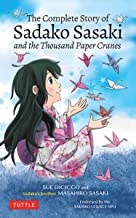Northern Lights Book Awards
Middle School Book of the Year
The Complete Story of Sadako Sasaki and the Thousand Paper Cranes
Authors: Sue DiCicco and Masahiro Sasaki
Publisher: Tuttle Publishing
The Complete Story of Sadako Sasaki and the Thousand Paper Cranes by Sue DiCicco and Masahiro Sasaki explores the heartbreaking story of Masahiro’s younger sister Sadako and how paper cranes became a symbol of peace and hope.
Sadako was only two years old when the atomic bomb dropped on Hiroshima, her hometown, during World War II. An estimated 140,000 people initially died from the bombing, but others suffered from burns, radiation, and injuries. Sadako seemed fine at first, but at the age of twelve, she became ill and was diagnosed with leukemia. During her nine-month illness, a brave Sadako learned to fold origami cranes. By folding a thousand paper cranes, Sadako hoped her wish would be granted and she would recover from her “atomic bomb disease.”
A loving and compassionate child, Sadako’s life inspired her classmates to create a memorial in her honor to remember all the children impacted by war. Sadako’s perseverance in the face of great pain and financial hardship became an inspiration for Japanese students who fundraised for The Statue for the Children of the Atomic Bomb in Hiroshima’s Peace Memorial Park.
The Complete Story of Sadako Sasaki and the Thousand Paper Cranes is a reminder of the essential goodness of humans. While it is difficult to talk to children about the harsh effects of war, the book manages to navigate tough topics with tact and grace. Optimism is woven through the undertones of the book. The back matter includes messages from both authors talking about the importance of learning from pain and turning it into something worthwhile.
The words of Kazumi Matsui, the mayor of Hiroshima, perfectly encapsulate what Sadako means to people worldwide, “The powerful message she proclaimed throughout her entire life still resonates with us all: Peace in our world can be achieved not through holding grudges but through striving to live our lives with compassion for others. Hope will be born from overcoming our differences, from profound understanding of one another, and from respect for our fellow human beings.”
Sadako’s story became known worldwide as a symbol of hope and a peaceful future for all. It will inspire you to consider the meaning of life and value the everyday things we take for granted. Omoiyari-no-kokoro, the act of showing empathy and concern, is the first step to building a more peaceful and sustainable world.
To unite students worldwide in a vision of peace, Sue DiCicco founded the Peace Crane Project in 2012. For more information on the legend of origami cranes and how they’re helping make the world a kinder place, please visit the Peace Crane Project Peace Crane Project or the authors’ website Sadako Sasaki

